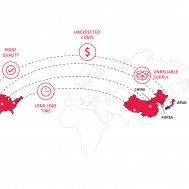COVID-19 has put manufacturers to the test, leaving many with disruptions and new gaps in their supply chain. Companies often outsource materials globally, but with world-wide shut downs, restrictions and shipping delays, these supply chains have suffered tremendously.
Looking ahead, supply chains around the world will have to update their strategies to make up for losses and be prepared for future disruptions that may arise. Here’s a closer look at what you can do to improve your supply chain after COVID-19.
Identify Vulnerabilities
Manufacturers often focus on ways to optimize their supply chain, cut down on costs and increase asset utilization in order to strengthen their supply chain and improve efficiency. While these measures are still important, they are not strong enough to absorb global shocks.
Instead of focusing on optimization, find areas in your supply chain that are particularly vulnerable. Whether your weaknesses are transparency through the chain or overall agility, it’s important to identify your problem areas first and work to improve them.
In the rubber industry, many manufacturers offshore were shut down due to the spread of the virus. In countries like China and Italy, where some of the largest rubber manufacturers are located, company shutdowns were enforced and many orders were unable to be fulfilled. Sourcing locally with Apple Rubber alleviates the uncertainty of offshore issues.
Strengthen Visibility
Visibility in a supply chain refers to the level of communication and transparency from end-to-end. Every member of the chain should know the status of shipments, production, levels of inventory and anything else that is critical to the end goal of the product. Without established visibility, you may be left in the dark for days, even weeks without updates on your materials or products, which leads to major lags in production.
Make sure lines of communication remain open between all members of the chain. Strengthening transparency will improve your chances of smooth operation if a global disruption occurs.
Companies should also invest time into contingency planning. These plans are used to assure products will continue to be shipped and supply chains will not suffer in the event of a catastrophic incident, such as a hurricane, terrorist attack or another life-threatening virus. Apple Rubber has created a contingency plan to reassure customers and guarantee quick production and delivery through any major disaster. Research the risks of a catastrophic event, identify them in your supply chain and develop a plan to minimize disruptions.
Leverage New Technology
Technology is constantly evolving to meet the demands of the market. For supply chains, new technology provides greater insight into working components and new ways to boost efficiency. Some of the newest technological advancements you should take advantage of include:
- 5G networks
- Robotics and automation
- Enhanced artificial intelligence
- Internet of Things (IoT) integration
Many companies choose to offshore for lower labor costs, however a number of local US manufacturers are turning to new technology to overcome higher labor costs. For Apple Rubber, investing in rubber injection machines and high-volume LSR molding capabilities allows us to improve our in-house operations and cut down our reliance on outsourcing.
Want to talk more about improving your supply chain?
Tweet us @AppleRubber to continue the conversation.
